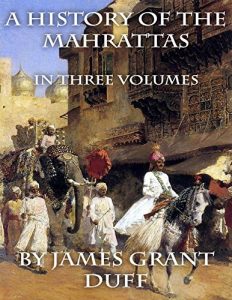A History of the Mahrattas: In Three Volumes by James Grant Duff.
The want of a complete history of the rise, progress, and decline of our immediate predecessors in conquest, the Mahrattas, has been long felt by all persons conversant with the affairs of India; in so much, that it is very generally acknowledged, we cannot fully understand the means by which our own vast empire in that quarter was acquired, until this desideratum be supplied.
Maharashtra is the native country of the people whose history it is now proposed to trace. Different limits are assigned to this great portion of the Deccan. According to the Tutwa, one of the books of the Jotush Shaster, or Hindoo Astronomy, Maharashtra extends no farther than the Chandore range of hills, where Kolwun, Buglana, and Candeish are represented as its northern boundary, and all beyond those countries is indiscriminately termed Vendhiadree.
James Grant Duff (1789–1858) was a British soldier, and historian from Scotland who was active in British India.
The want of a complete history of the rise, progress, and decline of our immediate predecessors in conquest, the Mahrattas, has been long felt by all persons conversant with the affairs of India; in so much, that it is very generally acknowledged, we cannot fully understand the means by which our own vast empire in that quarter was acquired, until this desideratum be supplied.
Maharashtra is the native country of the people whose history it is now proposed to trace. Different limits are assigned to this great portion of the Deccan. According to the Tutwa, one of the books of the Jotush Shaster, or Hindoo Astronomy, Maharashtra extends no farther than the Chandore range of hills, where Kolwun, Buglana, and Candeish are represented as its northern boundary, and all beyond those countries is indiscriminately termed Vendhiadree.
James Grant Duff (1789–1858) was a British soldier, and historian from Scotland who was active in British India.






